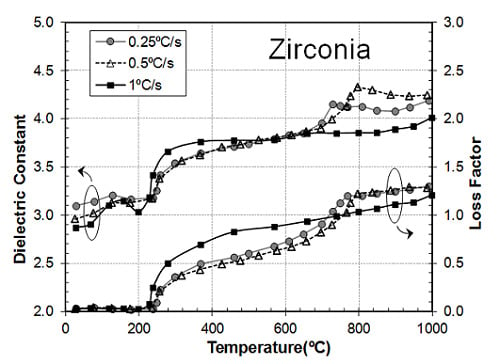In Situ Monitoring of Microwave Processing of Materials at High Temperatures through Dielectric Properties Measurement
Abstract
:1. Introduction
2. Microwave System Description
3. Results
4. Discussion
5. Materials and Methods
Author Contributions
Conflicts of Interest
Abbreviations
| IR | Infrared |
| ISM | Industrial Scientific and Medical |
| PDI | Proportional Derivative Integral |
| TE | Transversal Electric |
| TM | Transversal Magnetic |
| VNA | Vector Network Analyzer |
References
- Raman Mishra, R.; Kumar Sharma, A. Microwave–material interaction phenomena: Heating mechanisms, challenges and opportunities in material processing. Comp. Part A 2016, 81, 78–97. [Google Scholar] [CrossRef]
- D’yakonov, V.A.; Lukin, E.S.; Nefedova, N.V.; Pronin, B.F.; Filatov, A.N. High-temperature study of heat-shielding composite materials of the oxide-oxide class. Refractories Ind. Ceram. 2014, 54, 494–496. [Google Scholar] [CrossRef]
- Liu, W.; Xu, F.; Li, Y.; Hu, X.; Dong, B.; Xiao, Y. Discussion on Microwave-Matter Interaction Mechanisms by in situ Observation of “Core-Shell” Microstructure during Microwave Sintering. Materials 2016, 9. [Google Scholar] [CrossRef]
- Von Hippel, A.R. Dielectric Materials and Applications, 2nd ed.; Artech House: Boston, MA, USA, 1995; pp. 301–416. [Google Scholar]
- Iglesias, J.; Westphal, W.B. Supplementary Dielectric Constants and Loss Measurements on High Temperature Materials; Technical Report 203; MIT: Cambridge, MA, USA, 1967. [Google Scholar]
- Westphal, W.B.; Sils, A. Dielectric Constant and Loss Data; Air Force Materials Lab.-TR-74–250; Wright-Patterson Air Force Base: Cambridge, MA, USA, 1972. [Google Scholar]
- Couderc, D.; Giroux, M.; Bosisio, R.G. Dynamic high temperature microwave complex permittivity measurements on samples heated via microwave absorption. J. Microw. Power 1973, 8, 69–82. [Google Scholar]
- Xi, W.; Ting, W.R. A High Temperature Microwave Dielectometer. In Ceramic Transactions; Clark, D.E., Gac, F.D., Sutton, W.H., Eds.; American Ceramic Society: Westerville, OH, USA, 1991; Volume 21, pp. 215–224. [Google Scholar]
- Harris, N.H.; Chow, J.R.; Eisenhart, R.L.; Pierce, B.M. Dielectric Properties of Ceramics at Microwave Frequencies. In Ceramic Transactions; Clark, D.E., Gac, F.D., Sutton, W.H., Eds.; American Ceramic Society: Westerville, OH, USA, 1991; Volume 21, pp. 235–242. [Google Scholar]
- Hollinger, R.D.; Varadan, V.V.; Varadan, V.K.; Ghodgaonkar, D.K. Free-space measurements of high-temperature, complex dielectric properties at microwave frequencies. In Ceramic Transactions; Clark, D.E., Gac, F.D., Sutton, W.H., Eds.; American Ceramic Society: Westerville, OH, USA, 1991; Volume 21, pp. 243–250. [Google Scholar]
- Li, E.; Nie, Z.; Guo, G.; Zhang, Q.; Li, Z.; He, F. Broadband measurements of dielectric properties of low-loss materials at high temperatures using circular cavity method. Prog. Electromagn. Res. PIER 2009, 92, 103–120. [Google Scholar] [CrossRef]
- Fukushima, H.; Yamanaka, T.; Matsui, M. Measurement of dielectric properties of ceramics at microwave frequency. J. Jpn. Soc. Prec. Eng. 1987, 53, 743–748. [Google Scholar] [CrossRef]
- Hauschild, T.; Knöchel, R. Measurement of complex permittivity of solids up to 1000 °C. IEEE MTT-S Digest 1996, 3, 1687–1690. [Google Scholar]
- Varadan, V.V.; Hollinger, R.D.; Ghodgaonkar, D.; Varadan, V.K. Free-space, broadband measurements of high-temperature, complex dielectric properties at microwave frequencies. IEEE Trans. Instrum. Meas. 1991, 40, 842–846. [Google Scholar] [CrossRef]
- Basset, H.L.; Bomar, S.H. Complex Permittivity Measurements during High Temperature Recycling of Space Shuttle Antenna Window and Dielectric Heat Shield Materials; Technical Report NASA-CR-2302, A-1389; Georgia Institute of Technology: Atlanta, GA, USA, 1973. [Google Scholar]
- Nikawa, Y.; Guan, Y. Dynamic Measurement of Temperature Dependent Complex Permittivity of Material by Microwave Heating using Cylindrical Cavity Resonator. In Proceedings of the Asia-Pacific Microwave Conference, Bangkok, Thailand, 11–14 December 2007.
- Salsman, J.B. Measurement of Dielectric Properties in the Frequency Range of 300 Mhz to 3 Ghz as A Function of Temperature and Density. In Ceramic Transactions; Clark, D.E., Gac, F.D., Sutton, W.H., Eds.; American Ceramic Society: Westerville, OH, USA, 1991; Volume 21, pp. 203–214. [Google Scholar]
- Berteaud, A.J.; Badot, J.C. High-temperature microwave heating in refractory materials. J. Microw. Power 1976, 11, 315–320. [Google Scholar]
- Arai, M.; Binner, J.P.; Carr, G.E.; Cross, T.E. High Temperature Dielectric Measurements on Ceramics. In Ceramic Transactions; Clark, D.E., Gac, F.D., Sutton, W.H., Eds.; American Ceramic Society: Westerville, OH, USA, 1991; Volume 21, pp. 69–73. [Google Scholar]
- Baeraky, T.A. Microwave measurements of the dielectric properties of silicon carbide at high temperature. Egypt J. Sol. 2002, 25, 263–273. [Google Scholar]
- Soldatov, S.; Kayser, T.; Link, G.; Seitz, T.; Layer, S.; Jelonnek, J. Microwave Cavity Perturbation Technique for High-Temperature Dielectric Measurements. In Proceedings of the Microwave Symposium Digest (IMS), Seattle, WA, USA, 2–7 June 2013.
- Arai, M.; Binner, J.G.P.; Cross, T.E. Comparison of techniques for measuring high-temperature microwave complex permittivity: Measurements on an Alumina/Zircona system. J. Microw. Power Electromagn. Energy 1996, 31, 12–18. [Google Scholar]
- Hutcheon, R.; de Jong, M.; Adams, F.; Wood, G.; McGregor, J.; Smith, B. A system for rapid measurements of RF and microwave properties up to 1400 °C. Part 2: Description of apparatus, data collection techniques and measurement of selected materials. J. Microw. Power Electromagn. Energy 1992, 27, 93–102. [Google Scholar]
- Hutcheon, R.M.; de Jong, M.S.; Lucuta, P.; McGregor, J.E.; Smith, B.H.; Adams, F.P. Measurements of high-temperature RF and microwave properties of selected aluminas and ferrites used in accelerators. IEEE Part. Accelerator Conf. 1991, 2, 795–797. [Google Scholar]
- Gherson, D.; Calame, J.P.; Carmels, Y.; Antonsen, T.M.; Hutcheon, R. Open-ended coaxial probe for high temperature and broadband dielectric measurements. IEEE Trans. Microw. Theory Tech. 1999, 47, 1640–1648. [Google Scholar] [CrossRef]
- Yu, X.D.; Varadan, V.V.; Varadan, V.K.; Ghodgaonkar, D. In Situ Measurement of the Dielectric Properties of Ceramics with A Single Mode Microwave Heating Device. In Ceramic Transactions; Clark, D.E., Gac, F.D., Sutton, W.H., Eds.; American Ceramic Society: Westerville, OH, USA, 1991; Volume 21, pp. 251–259. [Google Scholar]
- Araneta, J.C.; Brodwin, M.E.; Kriegsmann, G.A. High-temperature microwave characterization of dielectric rods. IEEE Trans. Microw. Theory Tech. 1984, MTT-32, 1328–1335. [Google Scholar] [CrossRef]
- Dube, D.C.; Agrawal, D.; Agrawal, S.; Roy, R. “High temperature dielectric study of Cr2O3 in microwave region”. Appl. Phys. Lett. 2007, 90, 124105. [Google Scholar] [CrossRef]
- Catala-Civera, J.M.; Canós-Marín, A.J.; Plaza-González, P.; Gutiérrez Cano, J.D.; García-Baños, B.; enaranda-Foix, F.L. Dynamic Measurement of Dielectric Properties of Materials at High Temperature During Microwave Heating in a Dual Mode Cylindrical Cavity. IEEE Trans. Microw. Theory Tech. 2015, 63, 2905–2914. [Google Scholar] [CrossRef]
- Polo, D.; Plaza-González, P.J.; García-Baños, B.; Canós, A.J. Design of a Low Cost Reflectometer Coefficient System at Microwave Frequencies. In Proceedings of the 10th International Conference on Microwave and High Frequency Heating, Modena, Italy, 12–15 September2005; Volume 1, pp. 235–238.
- Scott, H.G. Phase relationships in the zirconia-yttria system. J. Mater. Sci. 1975, 10, 1527–1535. [Google Scholar] [CrossRef]
- Benavente, R.; Salvador, M.D.; García-Moreno, O.; Peñaranda-Foix, F.L.; Catalá-Civera, J.M.; Borrell, A. Microwave, Spark Plasma and Conventional Sintering to Obtain Controlled Thermal Expansion β-Eucryptite Materials. Int. J. Appl. Ceram. Technol. 2015, 12, E187–E193. [Google Scholar] [CrossRef]
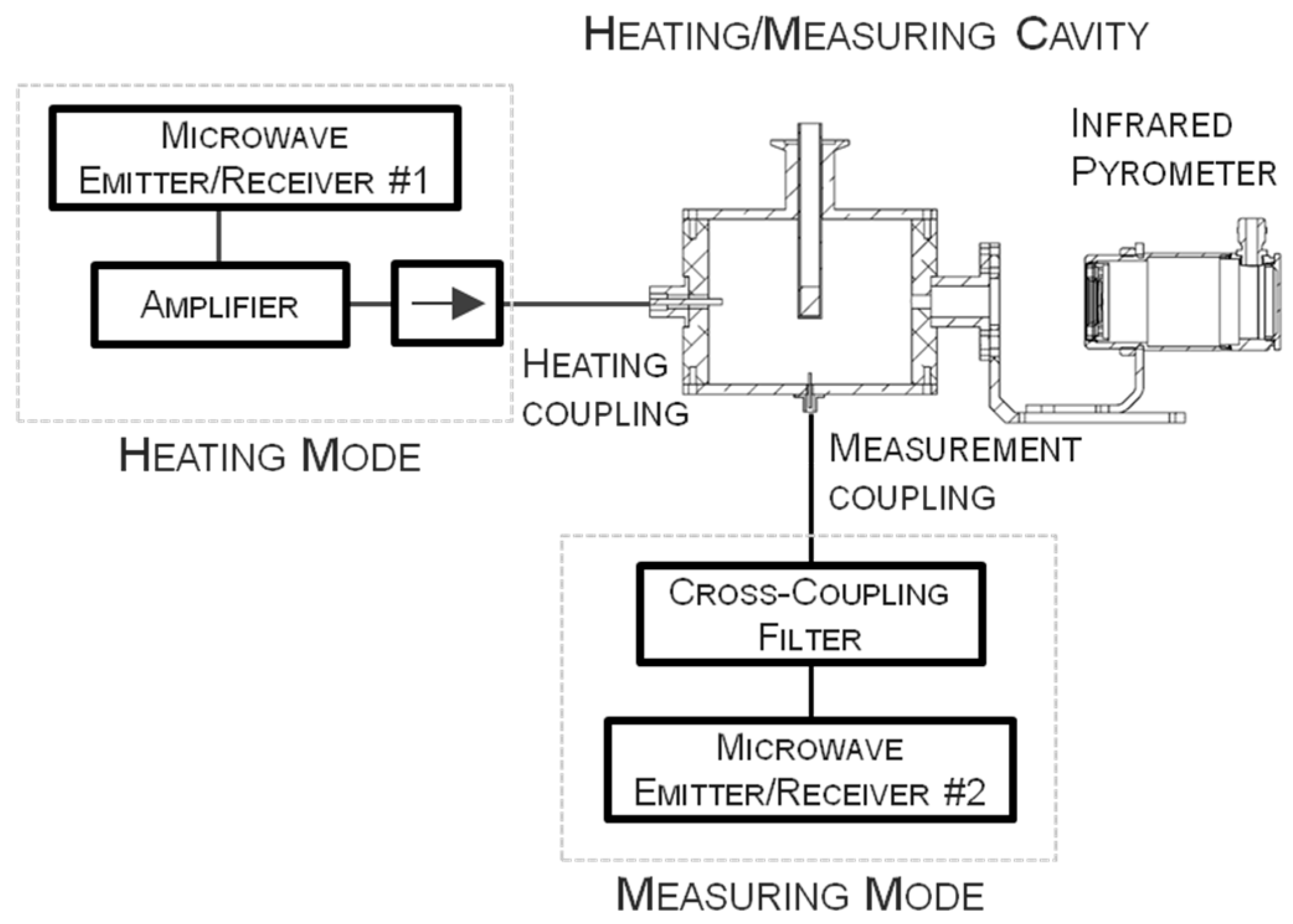
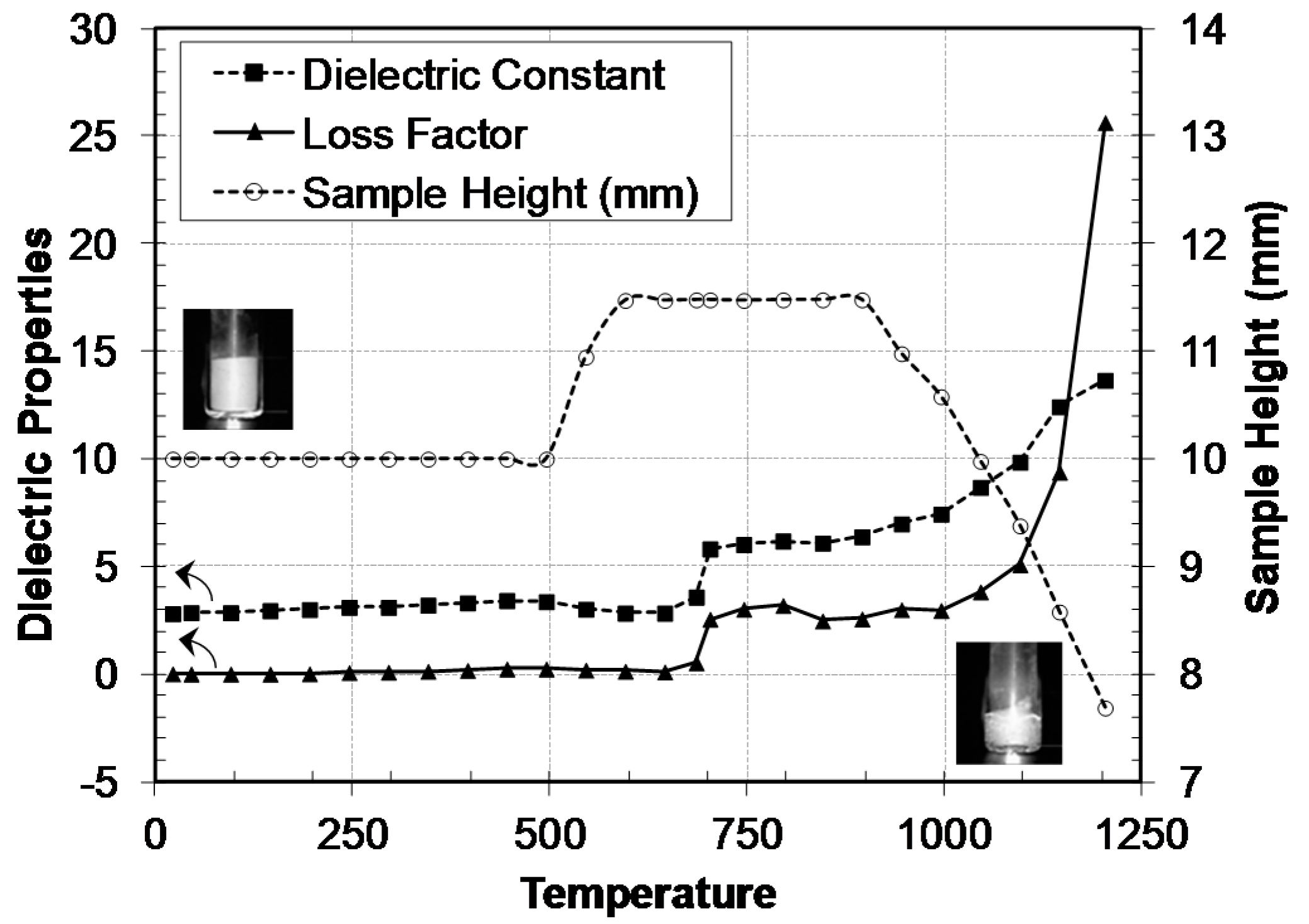
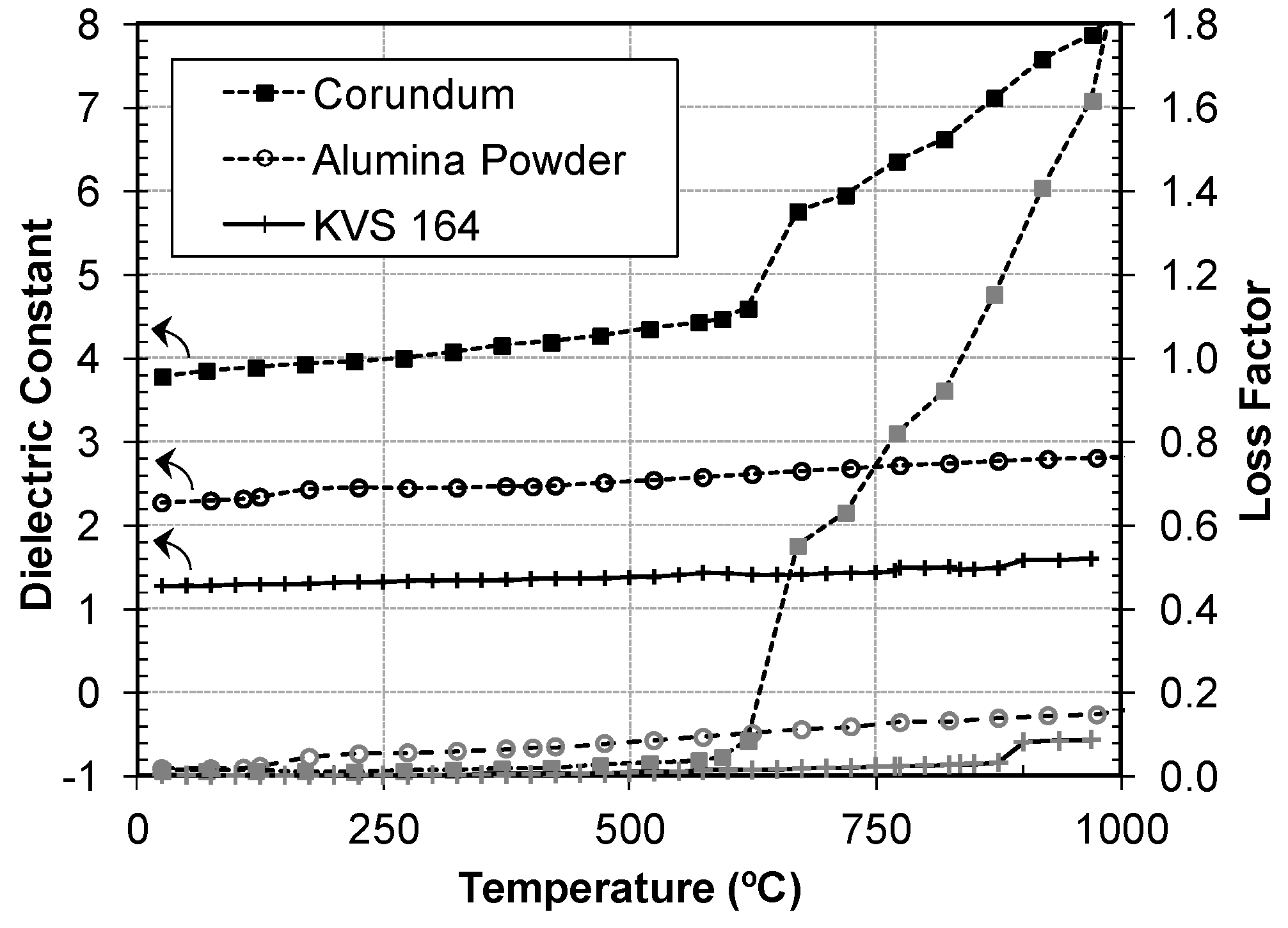
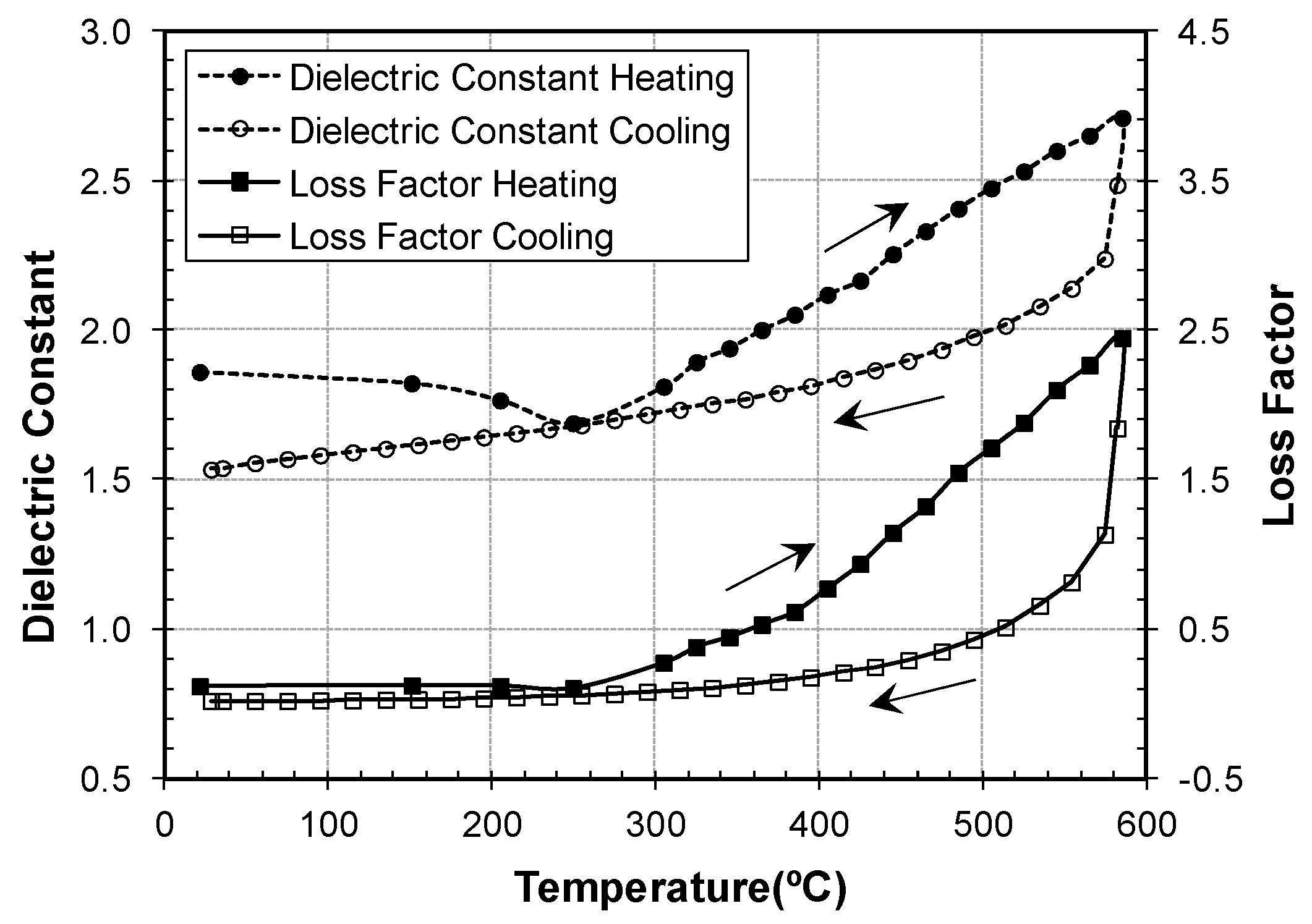

| Approach | References | Comments | |
|---|---|---|---|
| Measurements at frequencies different from ISM standard frequencies (2.45 GHz, 915 MHz) | [5,6] | Measurements in the Hz, KHz, MHz range | |
| [7,8] around 3–4 GHz [9] from 8 to 12 GHz [10] from 8 to 40 GHz [11] from 7 to 18 GHz [12] at 6 GHz [13] from 7 to 13 GHz, [14] from 6 to 40 GHz [15] at 9 GHz | Measurements in the GHz range | ||
| Measurements at intermediate temperatures (< 800 °C) | [16] <100 °C [9] <500 °C | [17] <325 °C | Max. Temperature <500 °C |
| [7,18] <600 °C | [10] <800 °C | Max. Temperature >500 °C | |
| Measurements with conventional heating | [5,6,9,13,14,15,17,18,19,20,21,22,23,24,25] | Only the sample is heated | |
| [11] | The cavity and the sample are heated | ||
| Measurements with MW heating and mechanical tuning | [11,12,16,18,26,27] | One mode for heating and measurement | |
| [7,8,28] | Different modes for heating and measurement | ||
| Measurements with MW heating without mechanical tuning | [29] | – | |
| Material | Description | Supplier | Density (g/cm3) |
|---|---|---|---|
| Ceramic Frit WP187® | Raw materials mix (Powder) | Keraben, Barcelona, Spain | 0.82 |
| ALTRA® KVS-164 | Thermal insulation board (Solid) with Al2O3 (65%)-SiO2 (34%) fibers | Rath Inc., Newark, DE, USA | 0.31 |
| Corundum | Al2O3 (99.9%) (Solid) | CeramTech, Nuremberg, Germany | 2.05 |
| Calcined Alumina | Calcined at 1250 °C, soda content (3000 ppm of Na2O) (Powder) | Alteo, Gardanne, France | 1.53 |
| Zeolite CBV100® | Type Y zeolite with silica/alumina mole ratio of 5.1 (Powder) | Zeolyst CV, Farmsum, the Netherlands | 0.51 |
| Zirconia TZ3YE® | Partially stabilized with 3% mol of Yttria | Tosoh, Tokyo, Japan | 1.42 (1 °C/s) 1.47 (0.5 °C/s) 1.48 (0.25 °C/s) |
© 2016 by the authors; licensee MDPI, Basel, Switzerland. This article is an open access article distributed under the terms and conditions of the Creative Commons Attribution (CC-BY) license (http://creativecommons.org/licenses/by/4.0/).
Share and Cite
Garcia-Baños, B.; Catalá-Civera, J.M.; Peñaranda-Foix, F.L.; Plaza-González, P.; Llorens-Vallés, G. In Situ Monitoring of Microwave Processing of Materials at High Temperatures through Dielectric Properties Measurement. Materials 2016, 9, 349. https://doi.org/10.3390/ma9050349
Garcia-Baños B, Catalá-Civera JM, Peñaranda-Foix FL, Plaza-González P, Llorens-Vallés G. In Situ Monitoring of Microwave Processing of Materials at High Temperatures through Dielectric Properties Measurement. Materials. 2016; 9(5):349. https://doi.org/10.3390/ma9050349
Chicago/Turabian StyleGarcia-Baños, Beatriz, Jose M. Catalá-Civera, Felipe L. Peñaranda-Foix, Pedro Plaza-González, and Gabriel Llorens-Vallés. 2016. "In Situ Monitoring of Microwave Processing of Materials at High Temperatures through Dielectric Properties Measurement" Materials 9, no. 5: 349. https://doi.org/10.3390/ma9050349
APA StyleGarcia-Baños, B., Catalá-Civera, J. M., Peñaranda-Foix, F. L., Plaza-González, P., & Llorens-Vallés, G. (2016). In Situ Monitoring of Microwave Processing of Materials at High Temperatures through Dielectric Properties Measurement. Materials, 9(5), 349. https://doi.org/10.3390/ma9050349







